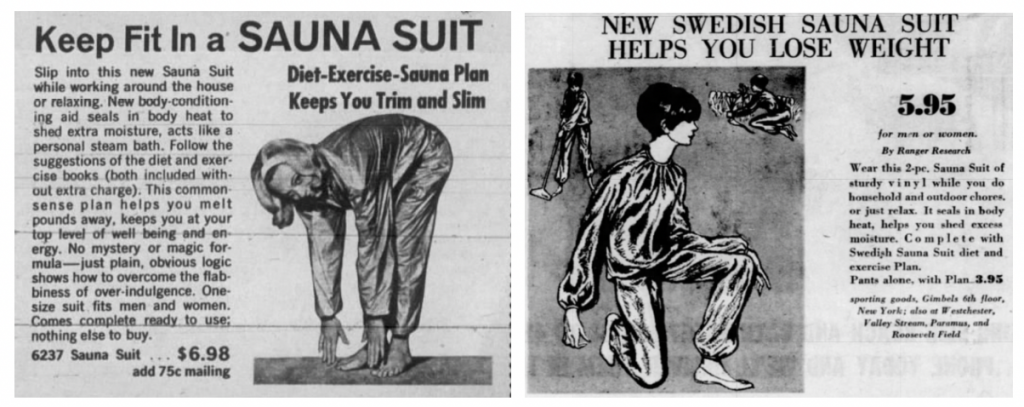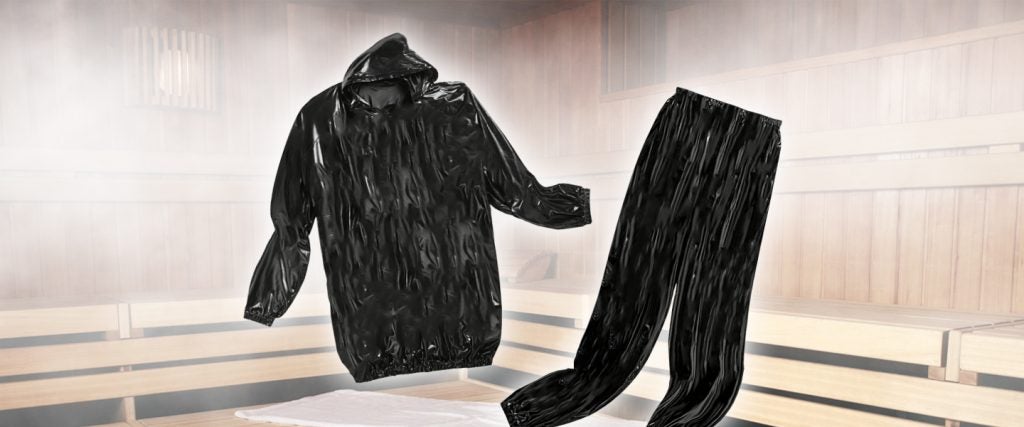Despite its silly name and beguiling history, the sauna suit has a unique place of honor amongst workout devices. No other piece of training attire has so skillfully walked the tightrope between poster child for abject fitness fraudulence and deus ex machina emergency weight-loss tool.
The seeds for the dichotomy that simultaneously casts the sauna suit as both scam and savior were sewn long before its invention. In the four decades following the nationally syndicated 1892 account of a visit to a Swedish bath house made by a Texas minister, interest in Swedish baths as a way to maintain good health and tame illness had spread across the U.S. with the speed of a steam room’s mist.
In most American publications, such as the popular “Beauty Chats” column of Edna Kent Forbes from December 1926, a Swedish bath was defined as a four-step process. “By the use of extreme damp heat, steam, massage and finally cold, the attendants in these bath places open the pores, cleanse them of impurities, remove the almost dead layers of skin which a warm bath would only help to shed and leave you feeling fresh, invigorated and with a complexion you never dreamed of possessing,” she wrote.
By 1932, local Swedish bath houses were advertising themselves as the restorative valhalla where anyone could sweat an illness straight out of their pores, and allow it to evaporate into the haze of the adjacent sauna.
Swedish bath houses also went out of their way to market themselves as a means of miraculous weight loss. It was at the 1932 Olympic Games in L.A. that Ivar Johansson made this case as compellingly as possible. First, he captured Olympic gold in the middleweight division of the freestyle wrestling tournament. Without pausing to celebrate his victory, he promptly visited a Swedish bath house and drained away the 11 pounds required for him to become eligible to compete as a welterweight in the Greco-Roman wrestling tournament, which he also won. From a public perspective, Johansson captured two gold medals in two different wrestling styles — and in two separate weight classes — just by visiting a Swedish bath and effortlessly sweating away his weight.
It was this true, yet grossly misunderstood episode that would spur the continuing popularity of Swedish baths for decades, and ultimately inspire the production of one of the most controversial fitness creations of all time.
Introducing the Swedish Sauna Suit
In 1960, Manuel Greenwald moved his Greenland Studios mail-order gift and novelty firm from snowy Pittsburgh, Pennsylvania, to sunny Hialeah, Florida, and drastically expanded his operations. It was from this location seven years later that the “Swedish Sauna Suit” would first be advertised to the masses, with millions of potential customers being coaxed into purchasing them by sending a check in the mail directly to Greenwald. Consumers were promised a “personal steam bath” that would enable them to “melt pounds away,” either by engaging in common exercises while wearing the suit, or by doing nothing other than donning it during ordinary household chores. Subsequent ads would directly state the sauna suit “burns up calories as you exercise,” more than suggesting that the suits were somehow enhancing the hard work of torching body fat.

Much of the sauna suit’s initial appeal is attributable to Patricia King, the syndicated beauty editor of the Newspaper Enterprise Association, who directly informed her readers in January 1967 that the suit was “Swiss-made,” evidently confusing Sweden with Switzerland, and being incorrect either way.
From there, she demonstrated that her understanding of physiology was as tenuous as her grasp on geography. “The slimming underwear produces a sauna-like effect on the wearer, causing her to perspire away extra liquid from the body tissues,” King wrote. “The material stimulates the body, inducing it to pour out perspiration. The excess fluid in the tissues is consumed, and the pads of fat broken down automatically. A reducing process begins which is particularly effective, but gentle in action. It eliminates the excess fat and water from your tissues by external processes, freeing you from pounds and inches.”
It clearly proved convincing. By the mid-1970s, sauna suits had become essential contributors to many of the spas administering body-wrap treatments. Per an Orlando Sentinel article from June 1974, spa goers were first wrapped in gray paper towels treated with chemicals and epsom salts, and then required to put on the sauna suits and sit motionless for an hour.
Not that there weren’t already skeptics. Audrey Squires of The Post-Standard of Syracuse, New York, incorporated her experience with the sauna suit into a column that dissected all of the methods and devices she’d used to try to shrink her way out of her size-nine dresses. “I even submitted to the sauna suit that was supposed to take inches off while I worked,” she wrote. “All I got from that was a bad case of body odor. I didn’t lose a lot of fat, but my friends disappeared in great numbers.”
The Feds Start Making the Sauna Suit Sweat
Just as the Federal Trade Commission (FTC) began cracking down on sauna-suit retailers for their false claims about suit-borne fat loss, prep athletes started garnering serious media attention for how the suits helped them drop weight so quickly (a la Johansson). In one early example, The Lompoc Record told the story of Chris Pickett, a sophomore on the 1977 high school wrestling team who weighed 155 pounds but who realized his best chance to gain substantive mat time was to make the dangerous cut down to 135 pounds. “To make weight for weigh-ins, [Pickett] would run five miles in a rubber sauna suit the day before a match, then take a sauna bath,” the paper reported. “Then he would run again and hit the sauna again, all on his own, the morning of the weigh-ins.”
Not long after, though, the National Federation of State High School Associations approved a rule that banned the use of rubber, vinyl or plastic suits worn for the purposes of initiating rapid weight loss. And in September 1978, the FTC made its official ruling that sauna suits were incapable of providing anything other than temporary size reduction unless accompanied by dieting or exercise.
The Sauna Suit Fight Game
In the 1990s, the sauna suit had more or less become the purview of combat sport competitors (the pros, of course, weren’t governed by the same rules as high schoolers). The decade began with it serving as a footnote to the success story of Michael Carbajal, who became the first fighter from the stacked 1988 U.S. Olympic Boxing team to capture a major world championship. When his IBF light-flyweight title win was initially reported, it was divulged that his opponent, Muangchai Kittikasem of Thailand, had tremendous difficulty making the 108-pound weight limit, and jumped rope while wearing a sauna suit in 104-degree heat for two hours in order to lose his final 1.5 pounds. Carbajal knocked out the exhausted, previously unbeaten Kittikasem in seven short rounds.
Exhaustion, however, was the least of it. Over a period of 33 days, three NCAA wrestlers at three different universities died under similar circumstances: Each was attempting to cut weight in order to qualify in their respective weight divisions, and each was reportedly wearing a sauna suit at the time of their death. The most high-profile death occurred on December 9, 1997, when University of Michigan sophomore wrestler Jeff Reese died of severe metabolic disruption during a workout performed in 92-degree heat while clad in a sauna suit, cotton sweatpants and a blue stocking hat. It was the final stretch of a four-day effort to drop 21 pounds.
Nearly two decades later, the NCAA would finally take action by banning the use of sauna suits and shortening weigh-in times prior to meets to eliminate the opportunity for wrestlers to recover from strenuous weight cuts before competitions, thereby rendering these actions to be nothing more than pyrrhic victories. The sauna suit, though, remains such an endemic part of combat sports culture that several of the most authoritative brands in fighting — including Everlast, Title Boxing and the UFC — sell their own versions for use by athletes of all ages.
And so, while the sauna suit has clearly felt the heat over the years — from the FTC, from prep sports governing bodies, from critics who never believed the wellness claims of its manufactures in the first place — it seems unlikely that its popularity will cool completely anytime soon.

